You may have different computers than what are pictured here, but the setup is sim-
ilar. The Router lets you share your fast cable or DSL connection among several com-
puters in your home or business. This is called a Local Area Network or LAN.
This Fast Start guide gives you the “big picture” of what you need to set up a basic
home or business network. The next three sections explain how you will set up and
configure your equipment to enable shared high-speed access to the Internet.
Step 1: Connect the Router
Connect the Router to your cable or DSL modem and to your notebook or desktop
PCs.
Step 2: Configure the PCs
Configure your notebook or desktop PCs to be able to communicate with the Router.
Step 3: Configure the Router
Do the basics to get the Router to work with your cable or DSL modem and your ISP’s
settings.
Step 1: Connect the Router
Step 2: Configure the PCs
Introduction
Introduction
Introduction
Connect Router
Connect Router
Connect Router
Configure PCs
Configure PCs
Configure PCs
Configure PCs
Congratulations! Thank you for choosing the Linksys EtherFast
®
Cable/DSL Router.
The Router allows you to set up a home or small business network to share your
high-speed Internet connection.
Why do I need a network? Networks are useful for sharing computer resources
such as printers, files, and CD-ROM drives. Networks are even used for playing mul-
tiplayer video games. So, not only are networks useful in homes and businesses,but
they can also be used for fun.
The most remarkable thing the Router does is to let you share your high-speed cable
or DSL connection to the Internet. The Router connects your LAN (Local Area
Network) to a WAN (Wide Area Network). The Internet is a network that,being glob-
al, covers the widest area of all! All PCs connected to the Router can share this con-
nection.
How is this accomplished? You will be setting up a simple LAN. Your PCs are con-
nected via Ethernet cable from an Ethernet adapter (in or attached to your PC) to one
of the Router’s LAN ports. The term “Ethernet” is used to refer to your network
accessories, such as cables and adapters, because Ethernet refers to the type of
network you are setting up.
Then the Router is connected to your cable or DSL modem. The Router makes it
seem as if each PC is connected directly to the Internet. Several PCs can then use
one Internet connection simultaneously.
Use the Linksys Router Setup Wizard CD-ROM or the instructions in this Fast
Start to help you connect the Router, configure your PCs,and configure the Router.
These instructions will get you up and running quickly using the most basic settings.
Once you have access to the Internet, you can get advanced configuration informa-
tion (for gaming, VPNs, web hosting, etc.) by visiting our website at
support.linksys.com
or by reading the User Guide on the Setup Wizard CD-ROM.
C. If you have the 1-Port Router, proceed to step C1. If you have the 3-Port Router
with USB, proceed to step C2.
C1.With the 1-Port Router, connect a
second Ethernet cable to your
PC’s Ethernet adapter or a port
on your hub or switch. Connect
the other end of the cable to the
LAN port on the back of the
Router.
Note: If your PC’s Ethernet adapter is not set up, please refer to the Ethernet
adapter’s user guide for more information.
If you are using the LAN port to connect to a PC, set the Crossover switch to
straight-through mode ( ll ). If you are connecting the Router to a hub or switch,
refer to the chart when setting the Crossover switch. Then proceed to step D.
C2.With the 3-Port Router with USB,
connect a second Ethernet cable
to your PC’s Ethernet adapter.
Connect the other end of the
cable to one of the LAN ports on
the back of the Router. Repeat
this process for every PC you
wish to connect to the Router.
Note: If your PC’s Ethernet adapter is not set up, please refer to the Ethernet
adapter’s user guide for more information.
Note: For ease of installation, start with LAN Port 3,then Port 2, and finally Port 1.
To use the USB port on the 3-Port Router,refer to the instructions in the User Guide
on the Setup Wizard CD-ROM.
If you are connecting more than four PCs to the Router, you will need to connect
a hub or switch to the Uplink port of the Router (if you use the Uplink port, then
you cannot use Port 1). Please refer to the User Guide located on the Setup
Wizard CD-ROM.
Proceed to step D.
D. Connect the power adapter to the Router. Connect
the power adapter to the electrical outlet. Turn on
the cable or DSL modem. Then turn on the first PC
you wish to use to configure the Router.
Proceed to Step 2: Configure the PCs on the next page.
In Step 1, you will connect the Router to your cable or DSL modem and to the com-
puters in your home or business.
First, make sure that all devices you’ll be working with are powered down,includ-
ing your PCs, modem, and the Router.
A. If you haven’t already done so,connect your cable or DSL modem to its proper
connection—the coaxial jack for cable (Figure A1), or the phone jack for DSL
(Figure A2). (Follow the instructions from your cable or DSL modem’s installation
guide.)
B. Use the Ethernet cable that had been used to con-
nect your cable or DSL modem to your PC. Connect
this Ethernet cable from the LAN or Ethernet port of
the cable or DSL modem to the WAN port of the
Router.
In Step 2, you will configure each of your computers to be able to communicate with
the Router.
To do this, you need to configure your PC’s network settings to obtain an IP (or
TCP/IP) address automatically (called DHCP). Computers use IP addresses to com-
municate with each other across a network or the Internet.
Find out which operating system your computer is running, such as Windows 95, 98,
Millennium, NT 4.0, 2000,or XP.
You will need to know which operating system your computer is running. You can
find out by clicking the Start button and then going to the Settings option. Then
click Control Panel, and then double-click the System icon. If your Start menu
doesn’t have a Settings option, you’re running Windows XP. Click the Cancel button
when done.
You may need to do this for each computer you are connecting to the Router.
The next few pages tell you, step by step,how to configure your network settings
based on the type of Windows operating system you are using. Once you've config-
ured your computers, continue to Step 3: Configure the Router.
A. Go to the Network screen by clicking the
Start button. Click Settings and then Control
Panel. From there,double-click the Network
icon.
B. On the Configuration tab, select the TCP/IP
line for the applicable Ethernet adapter*. If
the word TCP/IP appears by itself,select that
line.** Click the Properties button.
C. Click the IP Address tab. Select Obtain an IP
address automatically.
D. Now click the Gateway tab to ensure that the
Installed Gateway field is left blank. Click the
OK button.
E. Click the OK button again. Windows may ask
you for the original Windows installation disk
or additional files. Supply them by pointing to
the correct file location, e.g., D:\win98,
D:\win9x, c:\windows\options\cabs, etc. (if
“D” is the letter of your CD-ROM drive).
F. Windows may ask you to restart your PC.
Click the Yes button. If Windows does not ask
you to restart, restart your computer anyway.
*Note: Do not choose a TCP/IP entry whose name mentions DUN,PPPoE, VPN,or
AOL.
**Note: If there is no TCP/IP line listed, refer to the User Guide found on the Setup
Wizard CD-ROM or your Ethernet adapter’s user guide to install TCP/IP now.
A. Go to the Network screen by clicking the Start
button. Click Settings and then Control
Panel. From there,double-click the Network
and Dial-up Connections icon.
B. Select the Local Area Connection icon for
the applicable Ethernet adapter* (usually it is
the first Local Area Connection listed). Double-
click the Local Area Connection.
C. The Local Area Connection Status screen will
appear. Click the Properties button.
D. Select Internet Protocol (TCP/IP), and click
the Propertiesbutton.
E. Select Obtain an IP address automatically.
Once the new window appears, click the OK
button. Click the OK button again to complete
the PC configuration.
F. Restart your computer.
*Note: Do not choose a TCP/IP entry whose
name mentions DUN, PPPoE,VPN, or AOL.
The following instructions assume you are run-
ning Windows XP with the default interface. If you
are using the Classic interface (where the icons
and menus look like previous Windows versions),
please follow the instructions for Windows 2000.
A. Click to the Network screen by clicking the
Start button and then Control Panel. From
there, click the Network and Internet
Connections icon and then the Network
Connections icon.
B. Select the Local Area Connection icon for
the applicable Ethernet adapter (usually it is
the first Local Area Connection listed).
Double-click the Local Area Connection.
C. The Local Area Connection Status screen will
appear. Click the Properties button.
D. Select Internet Protocol (TCP/IP), and click
the Propertiesbutton.
E. Select Obtain an IP address automatically.
Once the new window appears, click the OK
button. Click the OK button again (or the
Close button if any settings were changed) to
complete the PC configuration.
F. Restart your computer.
If you are running:
Windows 95, Windows 98, Windows Millennium
If you are running:
Windows 2000
If you are running:
Windows XP
If you are doing a brand new setup,
please use the Fast Start guide to get
you up and running quickly!
Fast Start
Cable/DSL Router
www.linksys.com
Broadband Networking
Cable or DSL
Modem
Cable/DSL Router
PC with Ethernet Adapter
Notebook with Ethernet Adapter
This is What You Will Be Setting Up
B
D
E
E
D
B
B
C
C1
A1 A2
D
WAN
LAN
B
C2

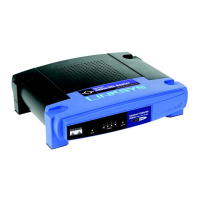
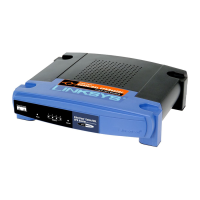


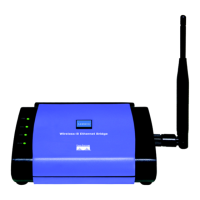
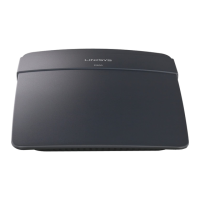
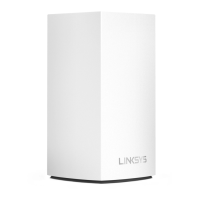
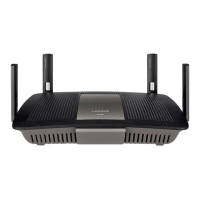
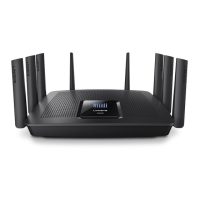

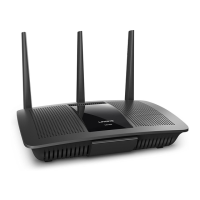
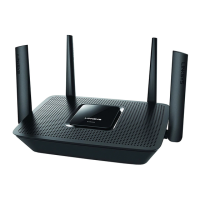
